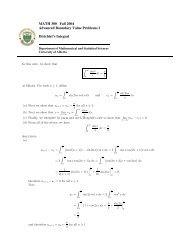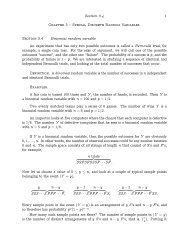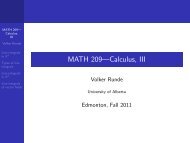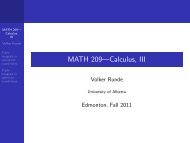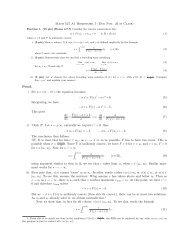Math 411: Honours Complex Variables - University of Alberta
Math 411: Honours Complex Variables - University of Alberta
Math 411: Honours Complex Variables - University of Alberta
Create successful ePaper yourself
Turn your PDF publications into a flip-book with our unique Google optimized e-Paper software.
Chapter 16<br />
Montel’s Theorem<br />
Definition. LetS ⊂ R N . AfamilyF <strong>of</strong>functionsonS intoR M iscalledequicontinuous<br />
if, for each ǫ > 0, there exists δ > 0 such that |f(x)−f(y)|< ǫ for all f ∈ F and for<br />
all x,y ∈ S such that |x−y|< δ.<br />
Lemma 16.1. Let S ⊂ R N . Then S contains a countable dense subset.<br />
Pro<strong>of</strong>. Let {x1,x2,x3,...} be a dense, countable subset <strong>of</strong>R N , e.g., Q N . For n,m ∈ N<br />
with S ∩B1 (xn) �= ∅, choose yn,m ∈ S ∩B1<br />
m<br />
m<br />
�<br />
yn,m : n,m ∈ N,S ∩B1<br />
m<br />
(xn). Then<br />
�<br />
(xn) �= ∅ ⊂ S<br />
is countable.<br />
Let ǫ > 0 and x ∈ S. Choose m ∈ N so large that 1 ǫ < m 2 . Since {x1,x2,x3,...} is<br />
dense in RN , there exists n ∈ N such that |xn−x|< 1<br />
and thus x ∈ S∩B 1 (xn) �= ∅.<br />
m m<br />
It follows that<br />
|yn,m−x|≤ |yn,m−xn|+|xn −x|< 2<br />
< ǫ<br />
m<br />
Theorem 16.1 (Arzelà–Ascoli Theorem). Let K ⊂ R N be compact, and let F be<br />
an equicontinuous and uniformly bounded family <strong>of</strong> functions from K to R M . Then<br />
every sequence in F has a subsequence that converges uniformly on K.<br />
Pro<strong>of</strong>. Let (fn) ∞ n=1 be a sequence in F, and let {x1,x2,x3,...} be a countable dense<br />
subset <strong>of</strong> K.<br />
Since(fn(x1)) ∞ n=1 isaboundedsequenceinR M ,thereexistsasubsequence(fn,1) ∞ n=1<br />
<strong>of</strong> (fn) ∞ n=1 such that (fn,1(x1)) ∞ n=1 converges.<br />
Since (fn,1(x2)) ∞ n=1 is a bounded sequence in RM , there exists a subsequence<br />
(fn,2) ∞ n=1 <strong>of</strong> (fn,1) ∞ n=1 such that (fn,2(x2)) ∞ n=1 converges.<br />
Continuing inductively in this fashion, we obtain, for each k ∈ N, a subsequence<br />
(fn,k) ∞ n=1 <strong>of</strong> (fn) ∞ n=1 such that, for each k ∈ N,<br />
107



